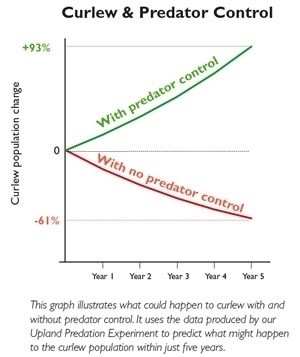By Andrew Gilruth, GWCT Communications & Membership Director
If we want to stop the curlew going the way of many other birds, such as the corncrake and the nightjar, we are going to need Defra to allow landowners to resume protecting the curlew’s young on their most important English breeding grounds – just as they can in Scotland and Wales.
These sites have been designated as Special Areas of Conservation and Special Protection Areas by Defra. However, having given them the highest level of legal protection – this red-tape is now preventing conservationists from protecting birds in them. With today being World Curlew Day, perhaps Defra might announce a resumption of their protection in England?
What is the problem?
On the curlew’s most important breeding grounds in England, Defra is preventing all control of species such as carrion crows to protect vulnerable curlew chicks – despite knowing the importance of this protection.
With one of the groups that advises the government, JNCC, stating that “the curlew is the UK’s most pressing bird conservation priority” and the British Trust for Ornithology (BTO) reporting that the carrion crow has “increased consistently since the 1960s”, surely it’s time for Defra to reinstate last year’s Individual Licences before another curlew breeding season is lost?
Will any reduction of chick protection contribute to curlew in crisis?
Yes. The overall problem is low breeding success, not poor adult survival. Across Europe the decline is well researched, and here in the UK Eurasian curlew numbers have dropped 46% in 25 years. What do we need to do? Protect the young.
A large review of scientific studies across Europe found that breeding success was so low that over 70% of nests between 1996-2006 were not able to hatch a single chick. Of those chicks that hatched, only half survived until they were able to fly. This is the reason the RSPB and other conservation groups kill crows to protect curlew. A point we have been willing to help the RSPB defend, despite the negative press coverage here.
Has Defra ever acknowledged the importance of protecting curlew chicks?
Yes. At the end of a Westminster debate on the decline of the curlew, three years ago, Dr Therese Coffey MP gave Defra’s response. This contained a commitment that predator control will now be included in all “current and future projects”.
Sadly, this has yet to happen. Instead the words of Richard Benyon, the MP that called the debate, remain just as true: “We should stop funding curlew conservation projects that do not include effective predator control options. We have to do what works, not what is popular.”

Do these special protection areas for some bird species still exist?
Yes. Defra oversees both the protection of our high-quality habitat through Special Areas of Conservation (SACs) and birds through Special Protection Areas (SPAs). This is why so many grouse moors have received these legal designations: they are some of the places with the most wildlife.
However, the 2020 conservation General Licence, in England, stipulates it can’t be used on these conservation sites of highest value. Last year Defra addressed this through the issue of Individual Licences, but this has not yet happened for this breeding season. Surely it makes sense to ensure English curlew chicks are as protected as those in Scotland and Wales?